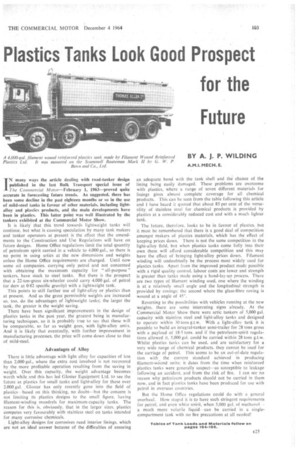Plastics Tanks Look Good Prospect for the Future
Page 105

If you've noticed an error in this article please click here to report it so we can fix it.
IN many ways the article dealing with road-tanker design published in the last Bulk Transport special issue of The Connnercial Motor—February 1, 1963—proved quite accurate in forecasting future trends. As suggested, there has been some decline in the past eighteen months or so in the use of mild-steel tanks in favour of other materials, including lightalloy and plastics products, and the main developments have been in plastics. This latter point was well illustrated by the tankers exhibited at the Commercial Motor Show.
It is likely that this trend towards lightweight tanks will continue, but what is causing speculation by many tank makers and tanker operators at present is the effect that the amendments to the Construction and Use Regulations will have on future designs. Home Office regulations limit the total quantity of petroleum spirit carried in a vehicle to 4,000 gal., so there is no point in using artics at the new dimensions and weights unless the Home Office requirements are changed. Until now some oil companies. carrying only petrol and not concerned with obtaining the maximum capacity for "all-purpose" tankers, have stuck to steel tanks. But there is the prospect that a 22-ton-gross six-wheeler could carry 4.000 gal. of petrol (or dery at 0.82 specific gravity) with a lightweight tank.
This points to still further use of light-alloy or plastics than at present And as the gross permissible weights are increased so, too, do the advantages of lightweight tanks; the larger the tank, the greater is the weight saving.
There have been significant improvements in the design of plastics tanks in the past year, the greatest being in manufacturing techniques, so it is probably true to say that these will be comparable, so far as weight goes, with light-alloy units. And it is likely that eventually, with further improvement in manufacturing processes, the price will come down close to that of mild-steel.
Advantages of Alloy
There is little advantage with light alloy for capacities of less than 2,000 gal., where the extra cost involved is not recovered by the more profitable operation resulting from the saving in weight. Over this capacity, the weight advantage becomes worth while and this has led Gloster Equipment Ltd. to see the future as plastics for small tanks and light-alloy for those over 2,000 gal. .Gloster has only recently gone into the field of plastics—based on this thinking, no doubt--but the concern is not limiting its plastics designs to the small figure. having filament-winding mandrels for maximum-capacity tanks. The reason for this is. obviously, that in the larger sizes, plastics competes very favourably with stainless steel on tanks intended for many corrosive chemicals.
Light-alloy designs for corrosives need interior linings, which are not an ideal answer because of the difficulties of ensuring an adequate bond with the tank shell and the chance of the lining being easily damaged. These problems are overcome with plastics, where a range of seven different materials for linings gives almost complete coverage for all chemical products. This can be seen from the table following this article and I have heard it quoted that about 85 per cent of the versatility of stainless steel for chemical products is provided by plastics at a considerably reduced cost and with a much lighter tank.
The future, therefore. looks to be in favour of plastics. but it must be remembered that there is a good deal of competition amongst makers of plastics materials, which has the effect of keeping prices down. There is not the same competition in the light-alloy field, but when plastics tanks come fully into their own these will afford considerable competition and this may have the effect of bringing light-alloy prices down. Filament winding will undoubtedly be the process most widely used for plastics tanks. Apart from the improved product made possible with a rigid quality control, labour costs are lower and strength is greater than tanks made using a hand-lay-up process. There are two types of filament winding used, one where the winding is at a relatively small angle and the longitudinal strength is provided by rovings; the second where the glass-fibre roving is wound at a angle of 45°.
Reverting to the possibilities with vehicles running at the new weights, there are some interesting signs already. At the Commercial Motor Show there were artic tankers of 5,000 gal. capacity with stainless steel and light-alloy tanks and designed to operate within 30 tons g.t.w. With a light-alloy tank it is possible to build an integral-tanker semi-trailer for 28 tons gross with a payload of 18.5 tons. and if the petroleum-spirit regulations allowed it, 5.000 gal. could be carried within 28 tons g.t.w. Whilst plastics tanks can be used, and are satisfactory for a very wide range of chemical products. they cannot be used for the carriage of petrol. This seems to be an out-of-date regulation with the current standard achieved in producing filament-wOund units: it dates from the time when reinforced plastics tanks were generally suspect—as susceptible to leakage following an accident, and from the risk of fire. I can see no reason why petroleum products should not be carried in them now, and in fact plastics tanks have been produced for use with petrol in overseas countries.
But the Home Office regulations could do with a general overhaul. How stupid it is to have such stringent requirements for petrol, and even white spirit, when 5.000 gal, of methanol a much more volatile liquid—can be carried in a singlecompartment tank with no fire precautions at all needed!
































































































































































































